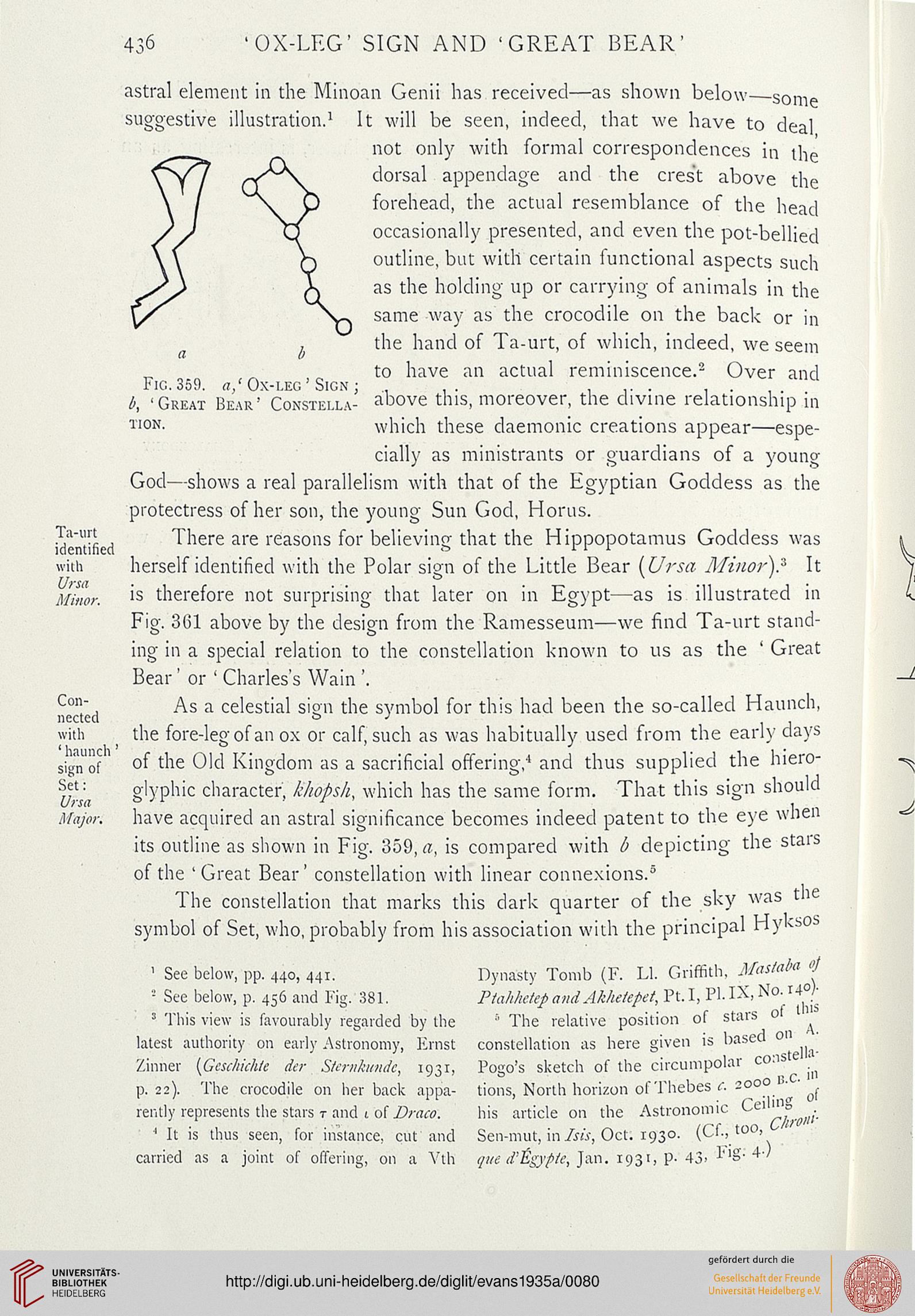436
'OX-LEG' SIGN AND 'GREAT BEAR'
Ta-urt
identified
with
Ursa
Minor.
Con-
nected
with
'haunch
sign of
Set:
Ursa
Major.
Fic. 359. a,' Ox-leg ' Sign
b, ' Great Bear ' Constella
tion.
astral element in the Minoan Genii lias received—as shown below—some
suggestive illustration.1 It will be seen, indeed, that we have to deal
not only with formal correspondences in t]le
dorsal appendage and the crest above the
forehead, the actual resemblance of the head
occasionally presented, and even the pot-bellied
outline, but with certain functional aspects such
as the holding up or carrying of animals in the
same way as the crocodile on the back or in
the hand of Ta-urt, of which, indeed, we seem
to have an actual reminiscence.2 Over and
above this, moreover, the divine relationship in
which these daemonic creations appear—espe-
cially as ministrants or guardians of a young
God—shows a real parallelism with that of the Egyptian Goddess as the
protectress of her son, the young Sun God, Horus.
There are reasons for believing that the Hippopotamus Goddess was
herself identified with the Polar sign of the Little Bear [Ursa Minor)? It
is therefore not surprising that later on in Egypt—as is illustrated in
Fig. 301 above by the design from the Ramesseum—we find Ta-urt stand-
ing in a special relation to the constellation known to us as the ' Great
Bear' or ' Charles's Wain '.
As a celestial sign the symbol for this had been the so-called Haunch,
the fore-leg of an ox or calf, such as was habitually used from the early days
of the Old Kingdom as a sacrificial offering,'1 and thus supplied the hiero-
glyphic character, k/wpsh, which has the same form. That this sign should
have acquired an astral significance becomes indeed patent to the eye when
its outline as shown in Fig. 359, a, is compared with b depicting the stais
of the 'Great Bear' constellation with linear connexions.5
The constellation that marks this dark quarter of the sky was the
symbol of Set, who, probably from his association with the principal Hyhsos
1 See below, pp. 440, 441.
- See below, p. 456 and Fig. 381.
3 This view is favourably regarded by the
latest authority on early Astronomy, Ernst
Zinher (Geschichle dcr SUrukmuh, 1931,
p. 22). The crocodile on her back appa-
rently represents the stars t and 1 of Draco.
'' It is thus seen, for instance, cut' and
carried as a joint of offering, on a Vth
Dynasty Tomb (F. LI. Griffith, MastaU oj
Ptahhetef andAklietepet, Pt.I, PI-I-X, No.i«
1 The relative position of stars ol
constellation as here given is based on
Pogo's sketch of the circumpolar cons ^
tions, North horizon of Thebes c. soo°B' '■„[
his article on the Astronomic Cel"L,,;.
Sen-mut, in Isis, Oct: 1930. (Cf., too,
que d'tgypte, Jan. 1931, P- 43, l''S- 4''
'OX-LEG' SIGN AND 'GREAT BEAR'
Ta-urt
identified
with
Ursa
Minor.
Con-
nected
with
'haunch
sign of
Set:
Ursa
Major.
Fic. 359. a,' Ox-leg ' Sign
b, ' Great Bear ' Constella
tion.
astral element in the Minoan Genii lias received—as shown below—some
suggestive illustration.1 It will be seen, indeed, that we have to deal
not only with formal correspondences in t]le
dorsal appendage and the crest above the
forehead, the actual resemblance of the head
occasionally presented, and even the pot-bellied
outline, but with certain functional aspects such
as the holding up or carrying of animals in the
same way as the crocodile on the back or in
the hand of Ta-urt, of which, indeed, we seem
to have an actual reminiscence.2 Over and
above this, moreover, the divine relationship in
which these daemonic creations appear—espe-
cially as ministrants or guardians of a young
God—shows a real parallelism with that of the Egyptian Goddess as the
protectress of her son, the young Sun God, Horus.
There are reasons for believing that the Hippopotamus Goddess was
herself identified with the Polar sign of the Little Bear [Ursa Minor)? It
is therefore not surprising that later on in Egypt—as is illustrated in
Fig. 301 above by the design from the Ramesseum—we find Ta-urt stand-
ing in a special relation to the constellation known to us as the ' Great
Bear' or ' Charles's Wain '.
As a celestial sign the symbol for this had been the so-called Haunch,
the fore-leg of an ox or calf, such as was habitually used from the early days
of the Old Kingdom as a sacrificial offering,'1 and thus supplied the hiero-
glyphic character, k/wpsh, which has the same form. That this sign should
have acquired an astral significance becomes indeed patent to the eye when
its outline as shown in Fig. 359, a, is compared with b depicting the stais
of the 'Great Bear' constellation with linear connexions.5
The constellation that marks this dark quarter of the sky was the
symbol of Set, who, probably from his association with the principal Hyhsos
1 See below, pp. 440, 441.
- See below, p. 456 and Fig. 381.
3 This view is favourably regarded by the
latest authority on early Astronomy, Ernst
Zinher (Geschichle dcr SUrukmuh, 1931,
p. 22). The crocodile on her back appa-
rently represents the stars t and 1 of Draco.
'' It is thus seen, for instance, cut' and
carried as a joint of offering, on a Vth
Dynasty Tomb (F. LI. Griffith, MastaU oj
Ptahhetef andAklietepet, Pt.I, PI-I-X, No.i«
1 The relative position of stars ol
constellation as here given is based on
Pogo's sketch of the circumpolar cons ^
tions, North horizon of Thebes c. soo°B' '■„[
his article on the Astronomic Cel"L,,;.
Sen-mut, in Isis, Oct: 1930. (Cf., too,
que d'tgypte, Jan. 1931, P- 43, l''S- 4''





